Caring for Vintage Leather with Wayne Jordan
Danna: Thanks, everybody, for joining us today. We’ve got a full house. This is awesome. Wayne Jordan has spent more than four decades restoring pianos, furniture, and antiques. In addition to serving homeowners, his shop contracted over 100 retailers and corporations, including Ethan Allen, MasterCraft, Mayflower, and others.
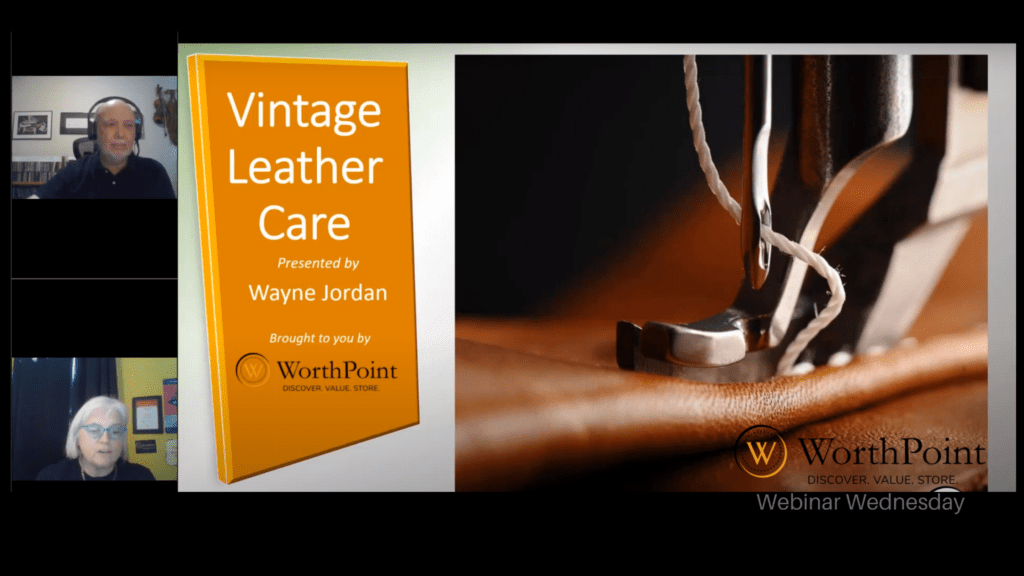
His work is found in museums, Virginia Military Institute, the Maryland Governor’s Mansion, and fine homes and institutions throughout the MidAtlantic states. He recently became the senior editor at WorthPoint, and I’m honored to not only work alongside him but to also learn from him. Thanks so much for doing this for us, Wayne. I can’t wait to hear your webinar. Thank you.
Wayne: I’m glad to be here.
Danna: I’m going to bow out, and you just take it away.
Wayne: Okay. First of all, thanks, Danna, for that nice bio. I think the short version of that is I can’t keep a job, but I enjoy what I do, and I’m going to share some of it with you today. I hope you get something out of it as well.
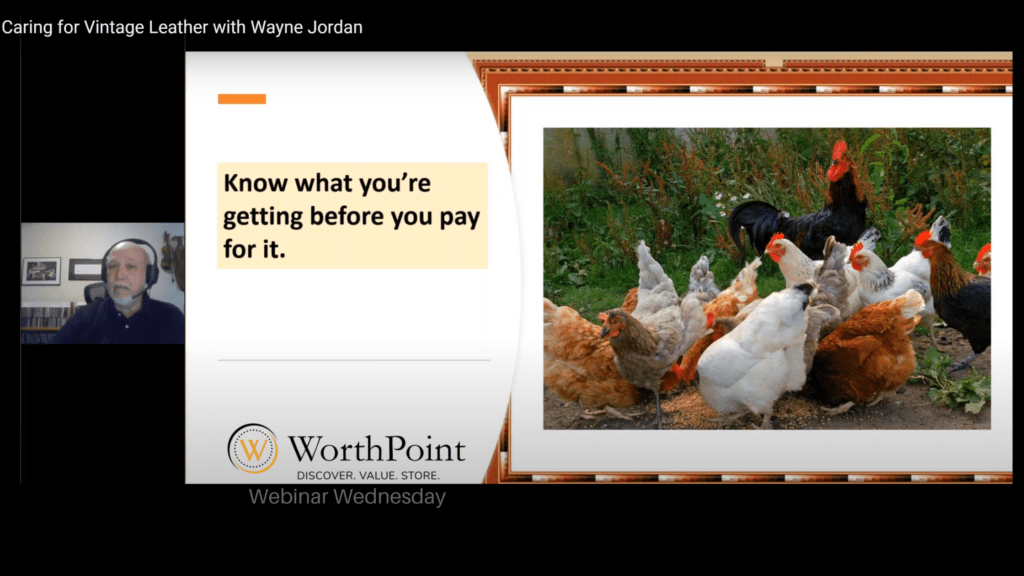
Of course, you signed up for Vintage Leather Care, and I’m going to start off by telling a story about chickens. The moral of this story is that you need to know what you’re getting before you pay for it. The story involves Jack, who is a city boy, and Ted, who is a farmer. Jack was out one Sunday afternoon speeding through the Blueridge Mountains to get away from the city. The windows down, the radio on. He was just cranking, taking those country turns pretty fast.
He went around one curve, and there in the middle of the road was a flock of chickens. So, he slams on his brakes, pushes on his horn. Chickens scatter everywhere, and then he hears, thump, thump.
He knew he hit a couple. He looked up in the yard there, and there’s Ted the farmer, and he is not happy. Ted comes out of the yard. “You killed my chickens. You killed my chickens. You owe me money.” Jack pulls the car over and turns off the radio, puts it in gear, turns off the ignition, gets out. Walks around to the farmer and says, “I’m really sorry I hit your chickens. I’m certainly happy to pay for them. Just tell me what I owe you, and you can be on your way, and I can be on my way.”
Ted says, “Well, let’s see. Four chickens at $3 apiece. You owe me $12.” Jack says, “There’s only two chickens lying in the road here. How do you get four chickens?” Ted says, “There’s two of them standing on the side of the road, and they look absolutely dazed. I guarantee you, I will never see an egg from either one of them, so four chickens.
You owe me $12.” Jack didn’t want to argue with him, so he reaches in his wallet and hands out the $12 and saunters over to his car and gets in and starts it up and drives gently down the road. Ted’s real happy.
Ted’s strutting across the yard counting his money, but his wife isn’t too pleased with him. She comes stomping down the steps, hands on her hips, going, “Theodore, why did you take that man’s money? You know there was only two dead chickens.” He says, “Yeah, but …” “Don’t give me that. Those other two’s roosters, and you know they’ll never lay an egg.”
That’s the story of Jack and Ted.
What’s the moral of the story?
Jack didn’t know his hens from his roosters, so he overpaid. What we’re going to do today is I’m going to figuratively tell you how to distinguish hens from the roosters. What you’ll learn today is you’re going to know the names of the primary five types of leather and what kind of things they’re used for, and you’ll learn a little bit about leather finishes. Those things are very important to know before you try to clean vintage leather or buy vintage leather items.
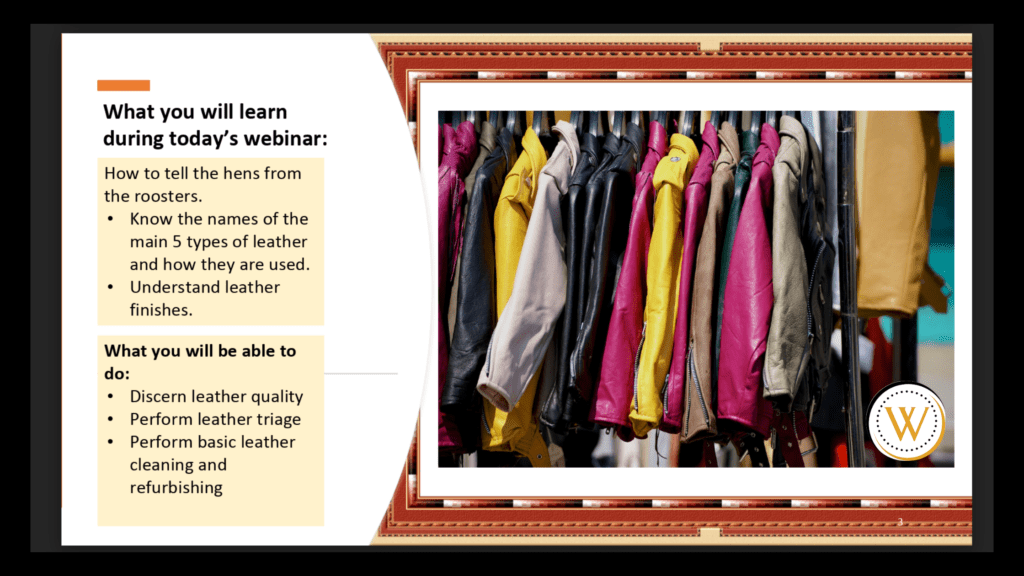
When we’re done today, you’ll be able to discern leather quality. You’ll be able to tell good leather from bad leather. You’ll be able to perform leather triage. Triage is my term for the way that I analyze leather. It’s actually a five-step process, and we’ll get into that. Then you’ll also learn to perform basic leather cleaning and refurbishing.
Let’s start with this guy.
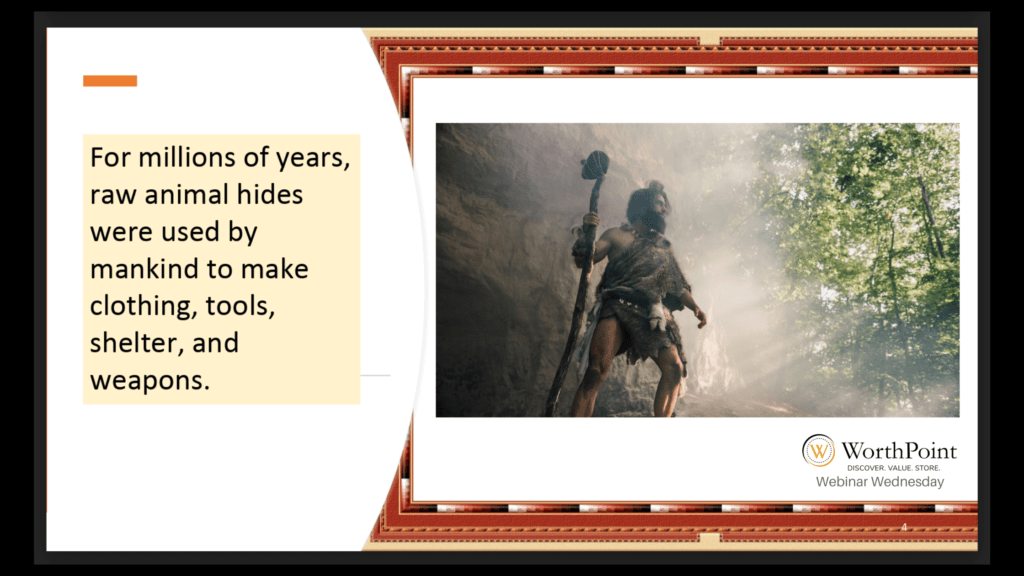
This is Mr. Caveman going back hundreds of thousands of years, and he’s very well attired for the time. He’s got on an animal hide, and then he has a club there that’s held together with strips of animal hide.
He’s got a little purse or bag on his waist there that’s made out of animal hide. Mankind has been using animals and animal hides for hundreds of thousands of years, but it’s important to understand that an animal hide is not the same thing as leather. If you scrape all of the hair off of a hide, you have a rawhide, what we still call rawhide. That’s not leather. Leather is treated in such a way to make it long-lasting and more durable.
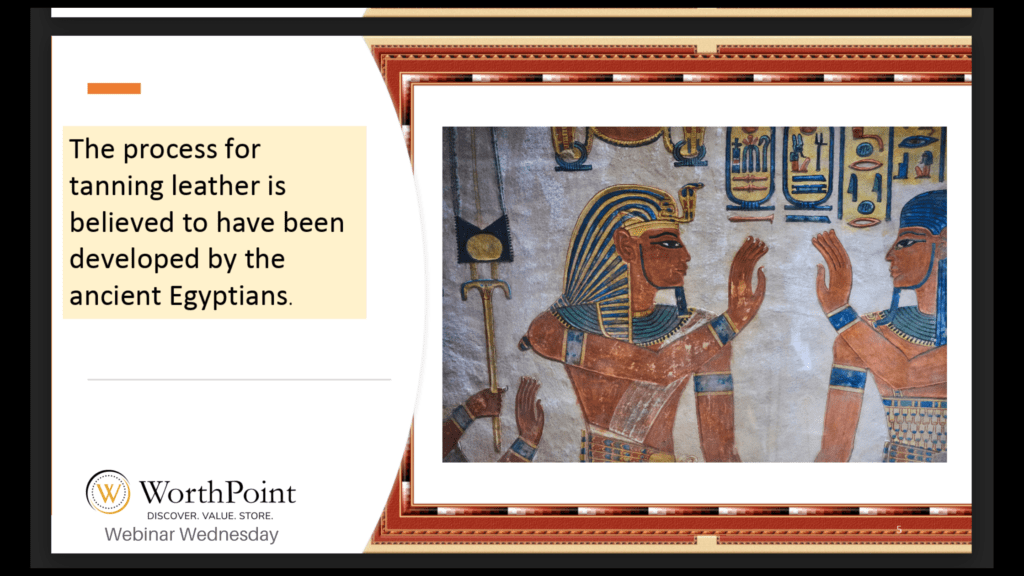
We have the Egyptians to thank for that. It’s believed that the Egyptians invented the process for tanning leather. Of course, they were a really clever culture. They would mummify their kings and queens and princes and princesses and put them in pyramids and tombs.
It’s suspected that somehow when they were learning how to mummify bodies that they developed the process of leather, tanning leather. Tanning, what that does is—the Egyptians used plant matter. They made big tubs of plant matter and water and mixed them up and adjusted the alkalinity and that sort of thing, and they would soak the hides in it.
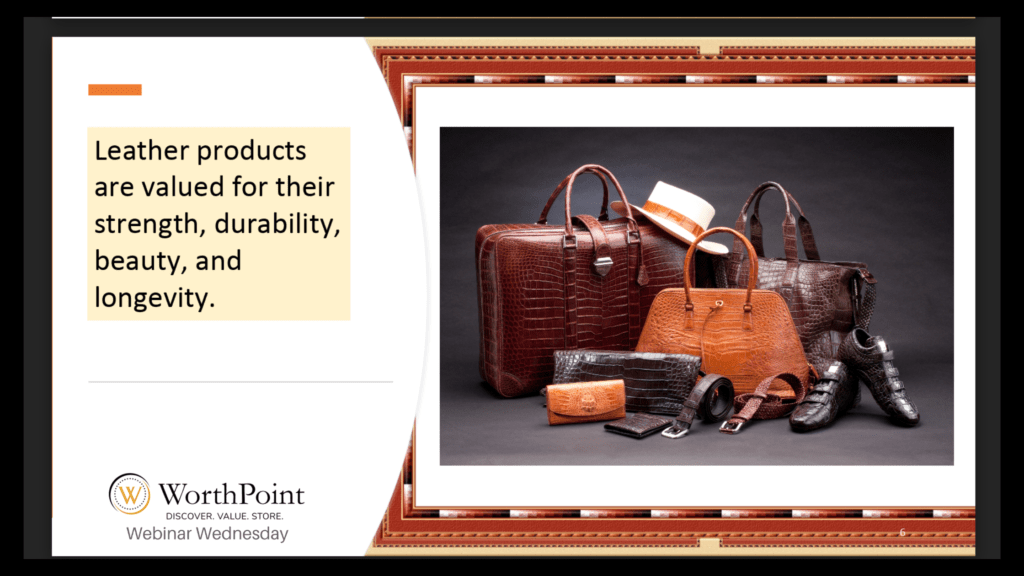
The differences in pH and chemical reactions, that sort of thing, would actually change the protein structure of the hide, and it would make it more durable and stronger, and they could do more things with it.
So, since the Egyptians developed that process, of course, leather has become everywhere. It’s used in just about everything. Clothing and luggage and shoes and wallets and belts and hats and all kinds of things. It will last a long, long time if you get good leather, and you take care of it. Taking care of it is what we’re going to learn to do today.
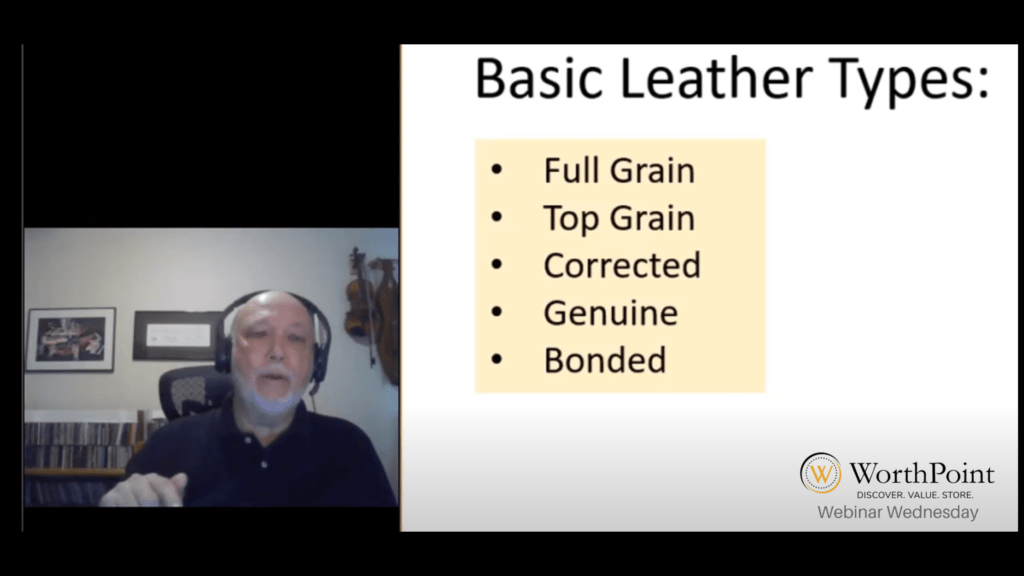
Different Types of Leather
Before we start, let me talk a little bit about the different types of leather. Leather manufacturers and leather retailers are just like all other manufacturers and retailers. They want their products to be special.
They want to stand out from the crowd. One way they do that is by giving things fancy names. I don’t know if anyone remembers the TV show from the ‘70s called Fantasy Island. The main character in Fantasy Island was a character named Mr. Roarke, and he was played by Ricardo Montalban.
In the ‘70s, while he was doing that show, Chrysler Corporation manufactured what they called a luxury car called the Chrysler Cordoba. Montalban did the TV ads for the Cordoba. I love those ads, because he’s a great actor, and when he was describing the interior of the car and the leather seats and the upholstery, he would say it’s, “Rich Corinthian leather.” I don’t do it justice.
The words coming from him would just roll off his mouth like honey, and you could almost reach out and touch those seats and feel the richness of the leather, just by the way he said it. Well, as far as I know there’s never been a tannery or a leather manufacturer in Corinth, so it was a complete fabrication used for advertising purposes. That happens all the time.
When you get rid of all the advertising mumbo jumbo, it comes down to four basic leather types. I know you’re counting five, and you don’t think I can count. Two of these are basically the same thing. I put it in here, so I don’t forget to tell you about it. What I’d like you to do, let’s play a little game before I go to the next slide.
There are five here, full grain, top grain, corrected, genuine, and bonded. Try to decide as I go through and talk about these five basic leather types, see if you can figure out which one is really the best, really the top of the pile.
We’ll start with full grain, because it’s at the top of the list. Full gives the impression that it’s full. It’s all of it. It’s the whole nine yards. It’s the whole shooting match. Full grain is all of the grain with nothing else left to the imagination.
Top grain, that could be the best too, because after all, top is the top. It’s the top of the pile, so maybe top grain is the best kind of leather. Corrected, we can kind of toss that aside, because if it’s having to be corrected, it can’t be very good. It must have done something wrong or have something wrong with it to be corrected.
Genuine, you see that one a lot. Genuine leather. Well, that’s the real deal, isn’t it? Genuine. Maybe that’s the best one. Bonded. Well, a bond, a performance bond, is when an insurance company steps in and insures a service provider, so that if they do something wrong their client will get their money back.
I’m bonded. When I apply for my auctioneer’s license to be renewed every two years, I have to buy a performance bond in order to get my license. So, bonded kind of gives the sense that it’s the best. It’s certified. It’s guaranteed. So, which one of these do you think is the best?
Let’s take a look at how it’s made, and maybe that’ll change your mind.

This image is a representation of how hides are cut, because they don’t take them right off of the animal and make something out of it, at least not anymore. What they’ll do, in this image the hide is a cowhide, they feed it into one end, and there’s a blade coming from the other side, and the hide is fed through, hits the blade, and is cut in half.
So, you have two cuts. You have a top cut and a bottom cut. Now, the top cut is the skin side of the hide. It’s the side that had the hair growing on it. That’s the skin side. The bottom cut is called the flesh side, and that’s the side that comes into contact with the inside of the animal, the fat and the steaks and the roasts and all of those good things, but it’s still leather.
The top cut can be called either full grain or top grain, depending how it’s processed. It’s the strongest part of the hide. It has all of the features. Anyway, the bottom side of this cut is weaker. It’s leather, but it’s not as strong as the top hide. It is sometimes cut again. Sometimes they’ll take this bottom piece and cut it again. The bottom cut is where we get genuine leather and bonded leather. You’re probably getting an idea of what might be the best.
Full Grain Leather
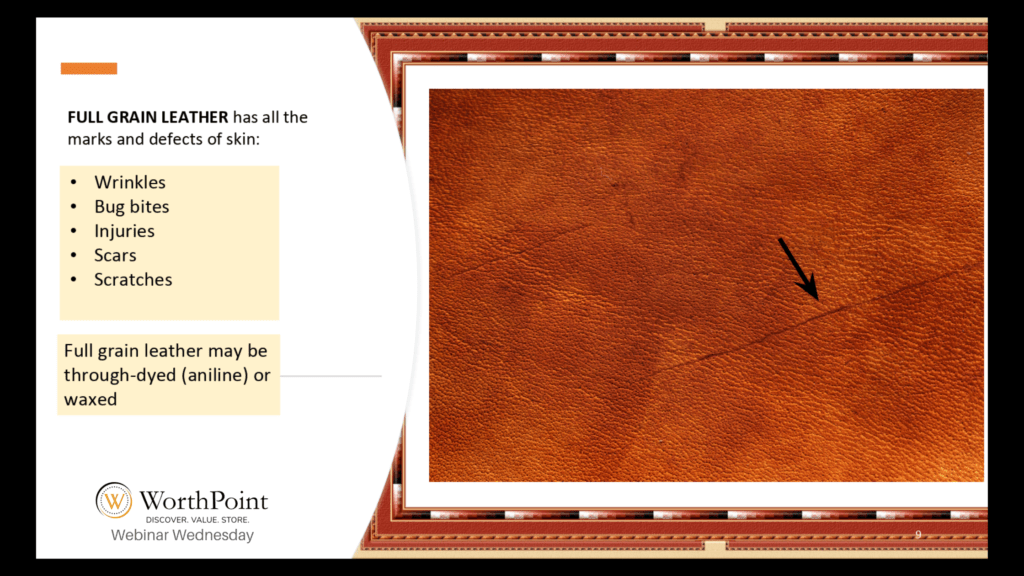
Full grain leather comes off the top cut, remember. Full grain leather has all the marks and defects of an animal skin. An animal skin has the same marks and defects that people skin has. For example, you’ll see where I have the arrow pointed to that scratch.
The animal must have rubbed up against a fence or some barbed wire or something and scratched himself and left a scratch in the hide. Then when the hide was dyed, the scratch became a receptacle for more stain, and it made it darker. You can also see down in the lower left corner how it’s wrinkly. There’s wrinkles coming up through the middle and other scratches. All of those are apparent on full grain leather.
What’s interesting is that the full grain leather is actually the most expensive leather. You wonder why, if it’s got all of these marks on it, that it’s the most expensive. If you think about wooden furniture, if you have woods that have a particularly nice grain or spalting or some kind of figured wood, that comes from insect damage to a living tree or animal damage to a living tree, and the tree has grown over the damaged part.
When you cut the boards, once you’ve harvested that tree, it makes a really nice piece of wood. It’s very pretty, and they’re very well sought after. That’s the same way with full grain leather.
This particular piece of full grain leather is dyed with an aniline die. That means it goes all the way through from the top to the other side. If you have a piece of leather in your hand, and you can see both sides of it, if it’s the same color on both sides, then it’s been aniline dyed. Interesting story about aniline dyed furniture. When my shop was active, before I retired, one of my clients was Ethan Allen.
They sold a big sectional sofa, aniline dyed, full grain leather, to a woman who lived in Potomac, and she was not happy. They sent me a service ticket, and I went out and looked at her sofa. It was full grain, aniline dyed leather. She saw all these marks and wrinkles and so on, on her leather sofa, and she was convinced that they had sent her an old beat up sofa, that it was not new.
So, I explained to her the same thing I’m explaining to you as to how it got that way and how it was regarded as the better cut of leather. She would have none of it. She said that for the money she paid she wanted a leather sofa that was flawless. Now, I was there to explain it to her, not to fix anything, because there was nothing wrong. I don’t know how that came out, but I did Ethan Allen’s work for years, and the way that they handle their customer service I suspect that they gave her what she wanted, and that they exchanged the sofa.
Top Grain Leather
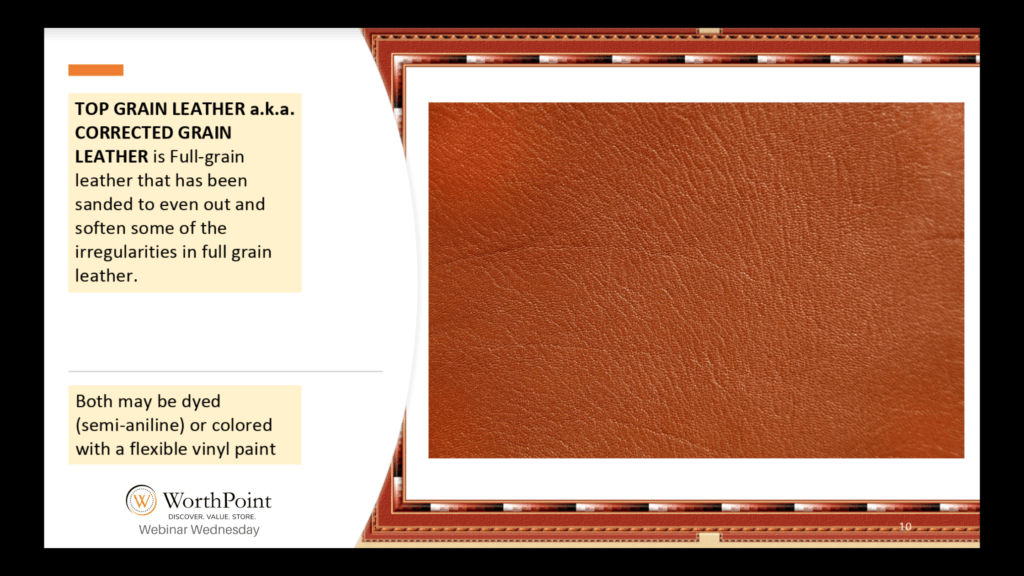
Next is top grain leather. Now, if a leather processor gets a hide, and they cut the full grain portion off of it, if it’s still just downright ugly, if it has too many marks, or it’s not thick enough, if there’s some kind of issue with the hide, then that becomes top grain leather. They may just fix it up a little bit, maybe taking out some flaws with sandpaper.
Leather can be sanded, just like wood. They may sand it a little bit. More often than not, what they do is they emboss a grain into it. Now, I doubt that this has an embossed grain, because you can see stretch marks or something going from the left side over to the right side on your screen there, and that’s a natural marking. Chances are, this one was just touched up, and then it had a finish applied to it.
Top grain leather can be aniline dyed, like full grain, or it can be colored. For example, in the ‘80s, one unfortunate circumstance of ‘80s style was turquoise leather sofas. Probably if there’s any left out there they’re still just as ugly as they were 40 years ago. Top grain leather can also have a colored coat put on top of it. It’s not exactly latex paint.
It’s a vinyl paint, but they will spray it on, and it adheres. It’s flexible, just like leather, and very often that’s what you see in luxury cars. Luxury cars will often have top grain leather upholstery, but it’s been sprayed. It has a finish on it. It has a color added to it to match the color of the car.
Genuine Leather
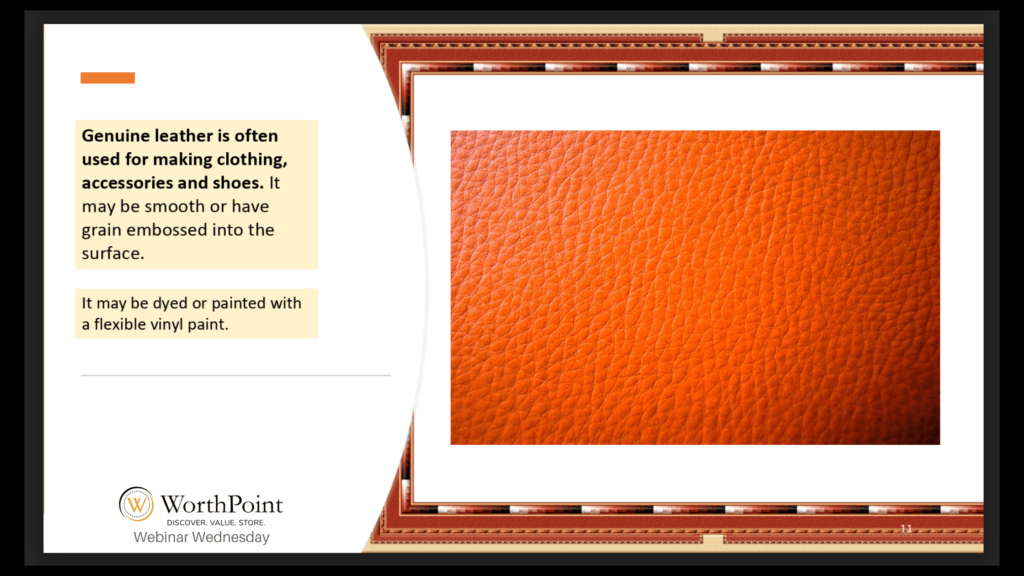
Let’s go down to the flesh side of the leather. This is genuine leather. Genuine leather is most often used for clothing, accessories, shoes, that sort of thing. It can be smooth, as in the case of most shoes, or it can have a grain embossed in it. What you see here is an embossed grain.
This is the most even grain that you’ve seen in a slide today. This is pressed into it with a machine that, depending on the pressure and the heat of the machine, will put this grain into it. Then they can paint it, like this orange here. I’ve yet to see an orange cow, so this is paint. It’s also more waterproof.
Full grain leather doesn’t have a sprayed finish on it usually. It has aniline dye, and then they might put a wax or something light on it. For as expensive as they are, they’re very susceptible to damage. If you’re sitting on your full grain leather waxed sofa, and you spill coffee or a glass of wine, you’re almost certainly going to have a permanent stain there.
It’s beautiful, but it’s hard to take care of. Leathers with finishes, like this one, the genuine leather, the top grain leather that has a sprayed finish, those are a lot more family friendly than the rest of them.
Bonded Leather
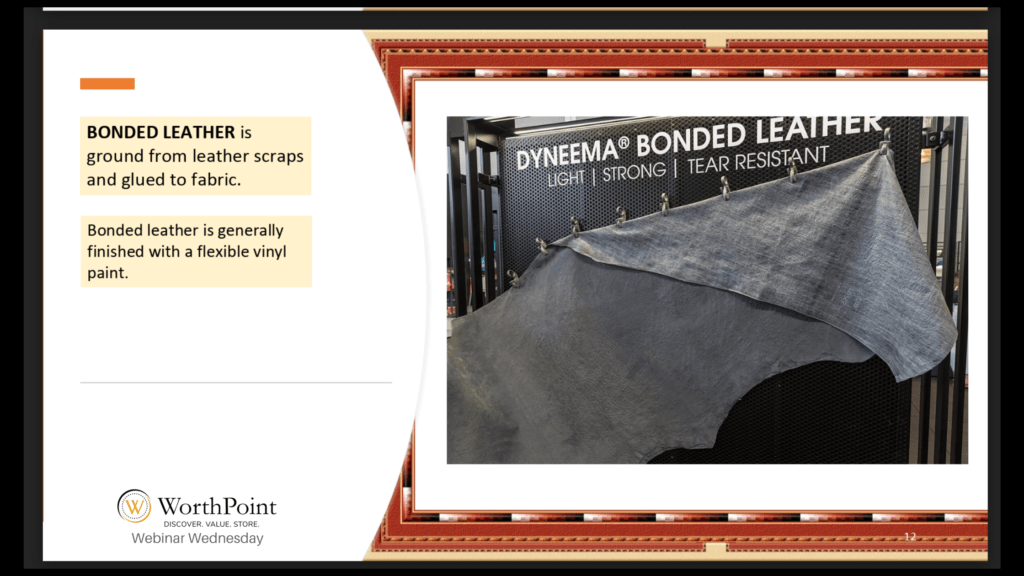
Now we get to the last one, and as you’ve probably determined, this is the low man on the totem pole. Bonded is, if this were meat it would be Spam or scrapple or something like that. In the process of manufacturing various leather products, there are a lot of scraps, little pieces you can’t do anything with or edges that have been trimmed or sections of a hide that were not usable. What manufacturers do is they take all of these things, and they grind them to a powder, and then they mix them with fibers, like polyester fiber or something similar.
They’ll mix it until they’ve got this fine powdery substance, and they will take a cloth backing, like the one that you see in the picture here and spray it with glue. Then spray the powdered leather and other fibers onto that, and then press it until it sticks. This bonded leather in most cases the most leather it has in it is 20%, not more. I’ve seen bonded leathers as low as 10%, but they still can be called leather.
All of those leathers, the first three leathers can last a long time. Bonded leather, if you buy a bonded leather sofa, it might look great in the store, but if you take it home and put it in your family room, and you’ve got kids and a dog, in six months you’re going to be ready to take it to the dump.
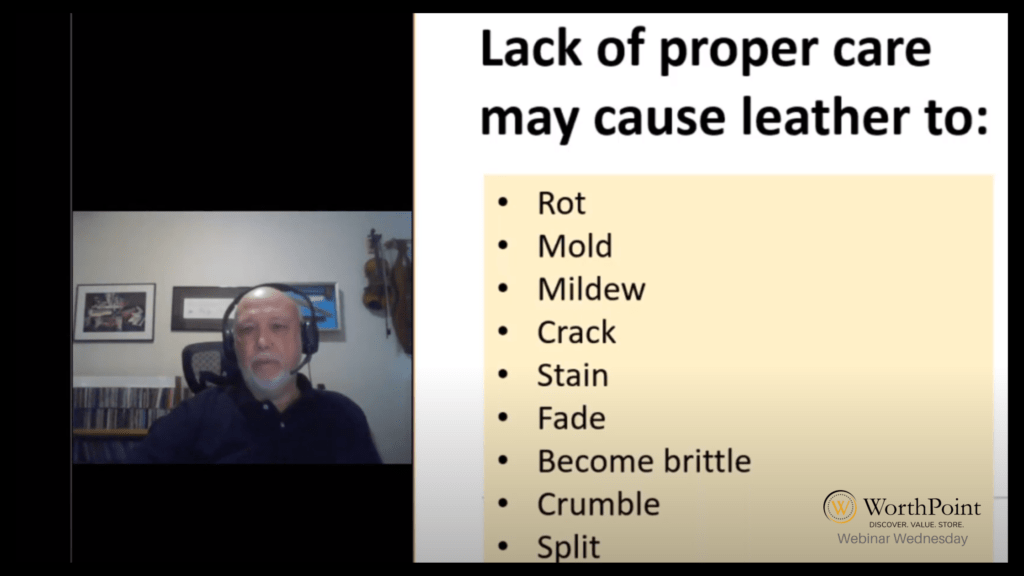
There’s not really a good way to take care of it except to keep it vacuumed. The other leathers are very durable, and they’ll last a long time, if you take care of them.
Here’s a few things that people see on a regular basis. There’s a pair of Victorian shoes, it looks like also Victorian era chairs there, a leather sofa, and some leather jackets. If you don’t take care of these things properly, they can rot and mold and mildew.
You see the cracks in the sofa back there. It can fade and become brittle, crumble, split. Some of these things are fixable by you as a consumer. Some of these problems require the attention of a professional, and some items you should just walk away from in the first place.
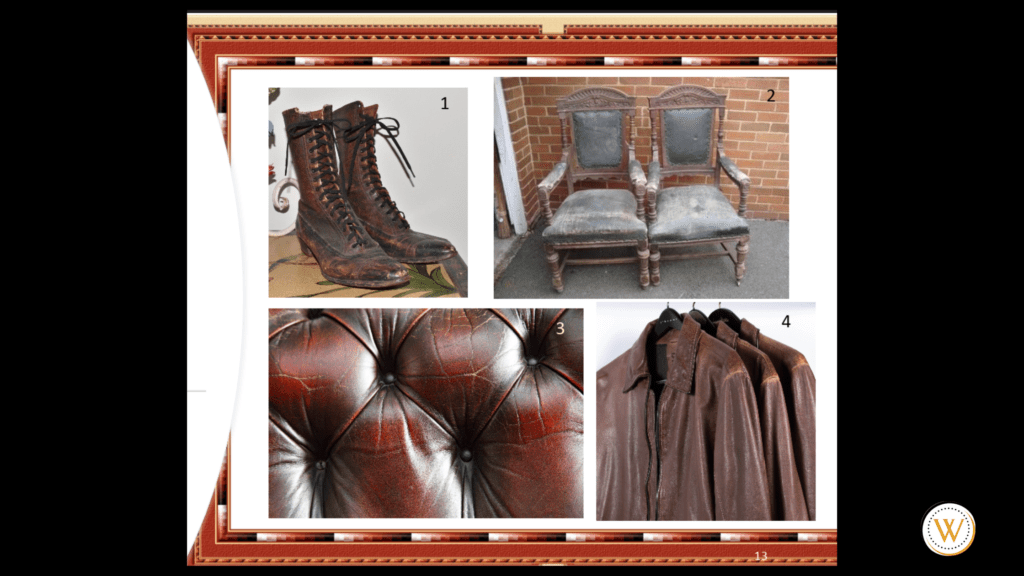
Let’s take a look at a few. When you’re out at a garage sale or an estate sale or something, and you find something that’s leather, and you’re wondering if it’s worth buying or not, here’s the method that I use when I assess leather. The first thing to ask yourself is what are you going to do with it? Is it like the Victorian shoes that are going to be put on a shelf and displayed, or a leather covered box or something that’s just going to be displayed, or are you going to use it?
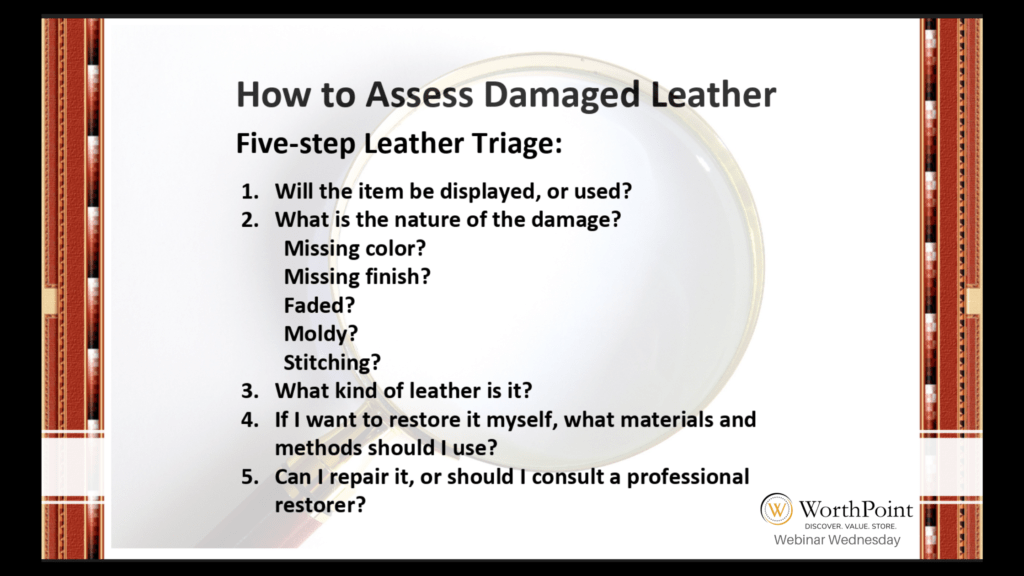
What’s the nature of the damage?
Is the leather missing color, or is the finish worn through? Is it faded or moldy? How’s the stitching? Even if the leather is wonderful, the stitching that holds the parts together, it doesn’t last nearly as long as the leather does. The older the leather, the more attention you have to pay to stitching. The next thing to ask yourself is what kind of leather is it?
The type of leather will directly affect what you’re able to do in terms of cleaning and restoration. The type of leather and the type of damage together are the two more important things to consider, if you’re looking at vintage leather. If you want to restore it yourself, what materials and methods should you use? Lastly, can you repair it, or should you consult a professional?
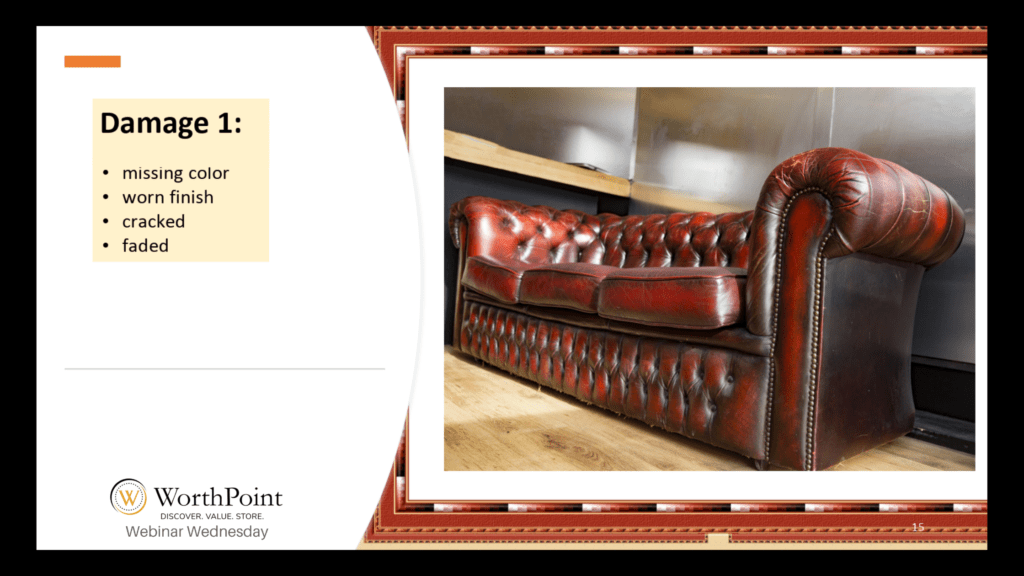
Let’s take a look at a few damaged items. The first one here, this leather sofa. This is the sofa. I got a closeup of the back, which I showed in a previous slide. This one is missing color, has a worn finish. It has cracked, and it’s faded. If you look on the arm closest to you, it would be the left arm if you’re sitting on the sofa, you see in the front there it’s cracked and missing some color.
That’s where the leather itself is actually starting to come apart. Then as you move further down the arm, you’ll see spots that are lighter. If it’s uneven, that’s where the finish has worn off. As you go toward the back of the arm, you can see that it appears to be faded. It’s tough to tell with this, because I don’t know exactly how the lighting in the room affected the photograph. Those are pretty standard issues anyway.
As far as this couch goes, whether you buy it or not, it depends on where you’re going to put it and what you’re going to pay for it. I would not buy this one personally, unless I was back in college living in a house with five guys in it, because this would be a perfect comfortable kick around sofa to have in the living room. I certainly wouldn’t put it in my home today. It needs too much work.
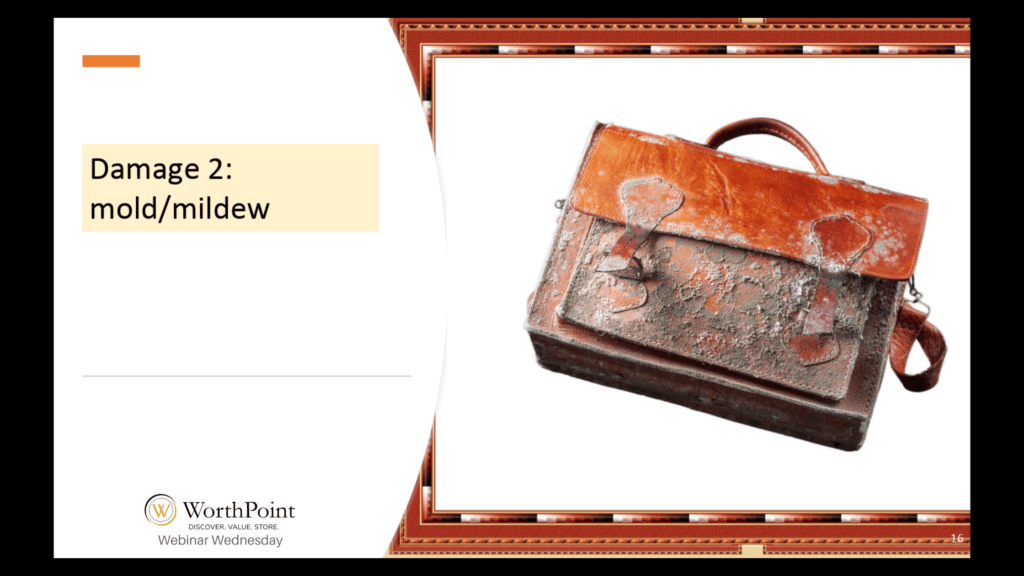
Here’s another thing you see a lot. This looks like it’s a computer case or some kind of shoulder bag, and mold and mildew is an issue. Of course, what you have here is mildew, because mold is usually black or brown most of the time. If you were to find this, would you buy it? Most people would walk away from it, but if I had a use for this, I wouldn’t hesitate to buy it, because even though it looks awful, that’s to my advantage, because they probably put a cheap price on it. Most folks would walk away.
For the mildew like this, what you do to get this off there and clean up this bag is you need a vacuum of some sort and a kitchen spatula, a rubber spatula, and a dust mask and a rag and some leather cleaner. The first thing you do is vacuum as much of this off as you can get, and then you start going at it with the spatula.
You just kind of scrap and push and vacuum it up as you go, because you don’t want to be breathing this stuff. Once you get as much of it off as you can get off, there will still be a thin coating on the leather, and that’s where using the leather cleaner comes in. I’ve got some slides and instructions on using leather cleaners later, so we’ll leave this one and move onto another one.

This is an art deco era club chair. I don’t know if the seat cushion is missing altogether, or if they just took it out for this picture. I love the shape of this chair. I’m an art deco fan, but this chair, I don’t know. You can see the arms clearly, that there are problems with the arms.
If you come out to the end of the arm, you see where it’s dark. That’s mostly from dirt. I imagine some guy coming home from work and sitting down in his favorite chair in short sleeves or a t-shirt, resting his sweaty arms on the chair night after night, year after year. Eventually, the dirt and the acids from perspiration and body oils, that sort of thing, wear through the finish, and then soak into the leather, and the leather just rots and comes apart.
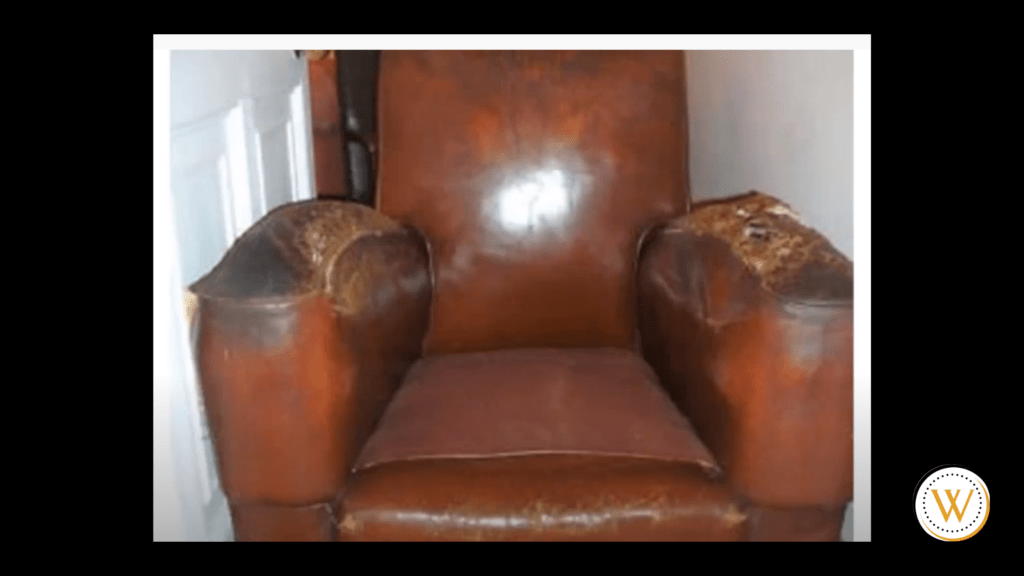
This cannot be fixed. It would have to be reupholstered. If this were mine, I’d probably redo it in something similar to what’s here, a smooth top grain leather with a finish on it, if I could afford to do that, because refinishing things, reupholstering things in top grain leather is fairly expensive. It certainly would be a beautiful chair if that was done. What we have here is issues of grease and rot.
Here’s one that book collectors see a lot.
This is called red rot. When you walk into a used bookstore, and you see leather bound books that have this kind of powdery red stuff on it, you can rub it with your finger. You could just keep rubbing and go right through it, because with red rot it’s a type of mold, and it’s not repairable.
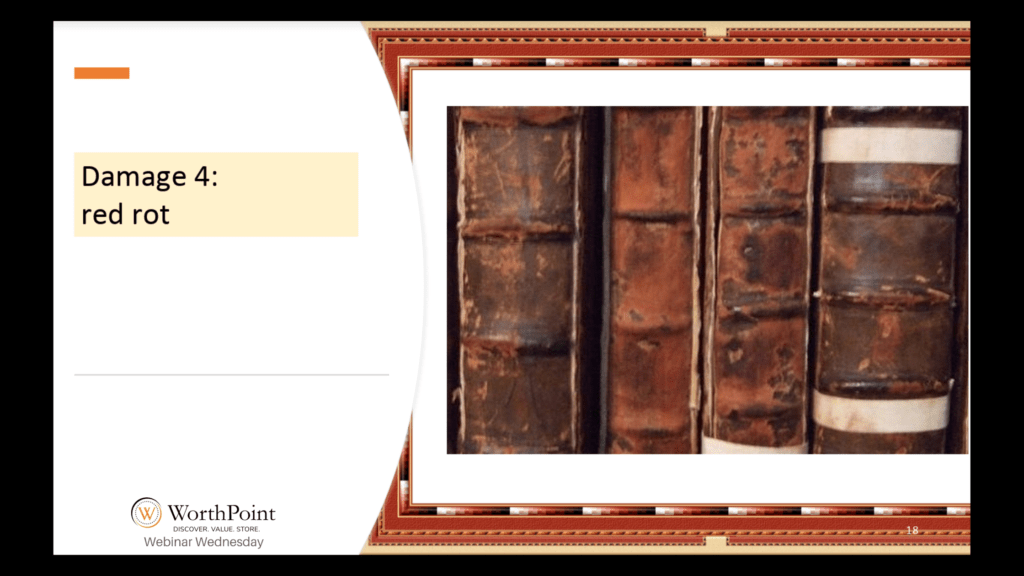
Most books like this are made with, maybe not these, newer books that are bound in leather primarily use bonded leather to make book covers. This is probably a better grade of leather, but people don’t think to clean and vacuum and condition their leather books. They just don’t think about it. They leave it on the shelves, and this is what happens. It’s called red rot, and it’s fairly common.
With these types of damages, should you fix them yourself or call a pro? When I’m asked that question, the best advice I can give you is look on the label. Leather clothing will have a label on it, and leather furniture usually has cleaning codes on a label that’s stitched under the cushion, one of the couch cushions or a chair cushion.
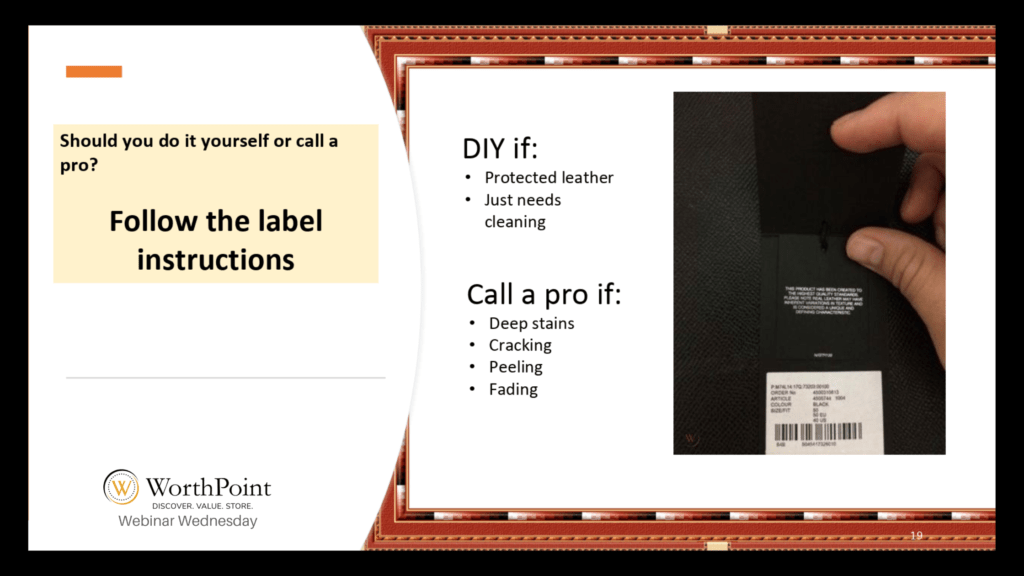
You can do it yourself, if it’s protected leather, if it has a finish on it. You shouldn’t personally try to clean a full grain aniline leather anything, because they’re very temperamental, and it would be easy to stain them. So, if it just needs cleaning, then you can do that.
Earlier I mentioned the ugly turquoise sofa from the ‘80s. I had occasion too many years ago, or maybe not enough years ago, where someone, they loved their sofa, and it was ugly turquoise, but they had taken care of it. The leather was in good condition. They just wanted it to be recolored. Remember, these are sprayed on finishes anyway. It’s like painting a dresser or a wall in a room.
If it’s clean and not greasy, if you can get all of that debris and dust and grease and so on off the leather, you can recolor it. In my shop, of course, I had spray booths and high volume, low pressure spray equipment and special lighting and fans and all that kind of stuff, but you don’t need all of that to recolor leather.
If you found a chair or a sofa, and you really liked it, it was in good condition, and you just wanted to refinish it, to put a new color on it, that’s a home project. You can do that in your garage, just like painting a dresser with milk paint. Only what you do is you still need the special vinyl paint, and there are places where you can buy it online. You can’t go to Home Depot and buy something like that.
If you have the paint, and you’ve cleaned it, and you buy a whole big bucketful of foam brushes, disposable foam brushes of various sizes, you can just paint it. I’ve seen ones that people have done, and they came out really nice. I’ve also seen people that have done that to their car leather, and it works perfectly fine. That’s something that you can do.
But if you’ve got something leather that has a light finish, like a wax or something on it, of course, suede and nubuck, you can’t clean at all. You’ve got to call a pro for that. If it’s cracking like that red sofa, if the leather is peeling, like if it had a backing, and it’s peeling, if it’s fading, those are things that you can’t do.
You really need a pro to do that. If you see something that you would love to buy, if it could be fixed, you need to get an estimate on getting it fixed before you buy it, or you’re going to find you can’t tell hens from chickens.

Let’s move on. The best method for cleaning leather, and I’m talking about protected leather here, is a foamer. Remember that in the process of tanning leather they change the protein structure, and they treat and dry out the leather.
Water and leather aren’t really a good combination.
You may have looked online to YouTube and seen videos where people would say, you just need this special cleaner, and you just throw it in the washing machine, and you turn it on. I would never put good leather in a washing machine. Never. It just doesn’t work to use that much water.
With a foamer though, the way to fill up a foamer, and you can get foamers most anywhere, is you go half to two-thirds with a good leather clean, and then the rest of it with water. As you pump the foamer, you get a nice foam. This picture here, I couldn’t really find anything that looked like it foamed well. This is pretty anemic foam, but the ones that I use, it almost looks like shaving cream, it comes out so thick.
When I cleaned leather furniture, I’d have a great big natural sponge in one hand and a white terry towel in another one. I’d pump the foam right onto the sponge, go in a circular motion, and then wipe it off with the towel. As long as dirt was coming off, I’d keep at that spot and keep going.
Of course, eventually we had service trucks out on the road, and I’d stock all of them with leather cleaning supplies. One of the things we offered is we offered annual contracts for cleaning. People would have us in once a year to clean their leather and condition the leather.
It’s like going to a dentist once a year or having your piano tuned once a year or whatever. This is the proper way to clean leather furniture and jackets. You could use it on shoes, but shoe polish works best, because it tends to keep your shoes dry.
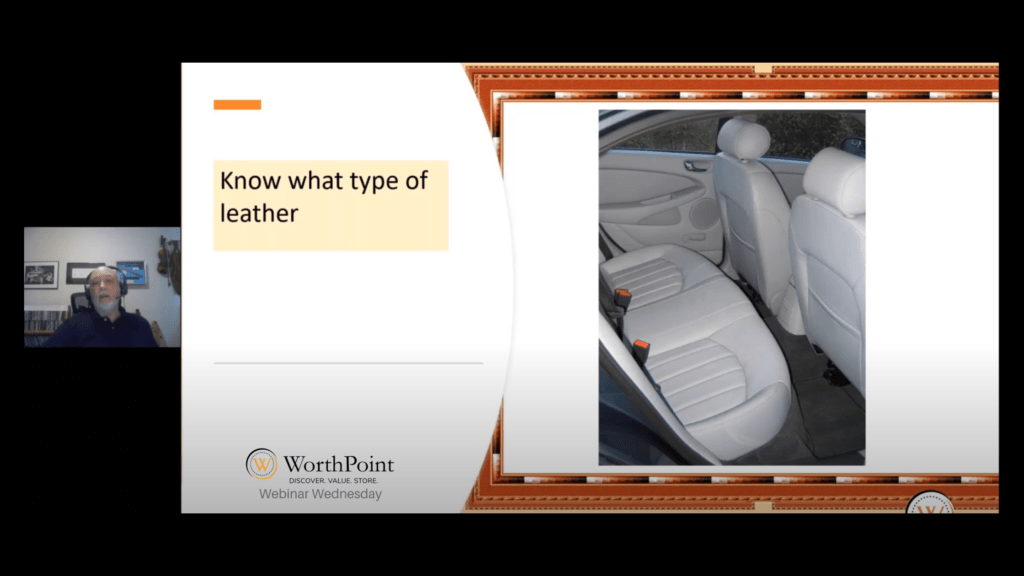
This is a Jaguar, and this is protected leather. Of course, it’s beautiful. The reason this slide is in here is that not all leather cleaners are the same. Remember leather in an automobile is protected leather. It needs to be, because automobile upholstery is subject to high heat and cold and spills and all kinds of things.
It’s almost bulletproof, auto leather. The best place to find cleaner for your car is at an automobile supply store, because they’ll have a shelf full of them. Just go and pick out the one you like the best and follow the directions. You can use that on your upholstery but you can’t use car cleaner on your leather furniture or on your clothing. You can’t do that. It will ruin it.
If you have any doubt as to whether the cleaner you buy is going to do the job you want, then the first thing you should clean is something in an inconspicuous place. You don’t want to go right to the front of the jacket or the headrest of the chair, and then find out that it’s too strong, and it’s going to remove the finish and the color.
This is the brand of products that I used.
I tried a bunch of them. This one is the best one, in my opinion. Once I found this, I never used anything else for years. This company, Leather Master, has a big line of products. They have pens that will remove ink stains and all kinds of interesting little things.
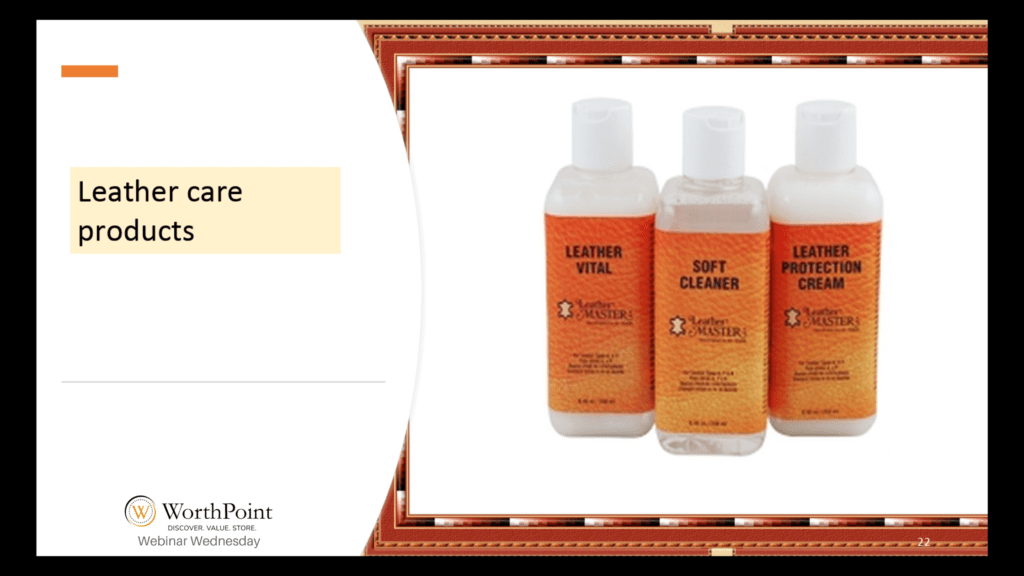
What you see here, the leather vital, I don’t want else to call it, it’s like essential oil of leather. It’s made from the oils that come out of leather hides. Soft cleaner is what you would put in a foamer to clean. They also have a strong cleaner for something that’s really dirty, and leather protection cream. They have a full line of products. I don’t make a dime from pushing Leather Master. I recommend it because I’m familiar with it, and I know it’s good.
I will give you a little word of advice here. You can buy this online, if you can’t find it in your local area. The best place to find leather cleaning supplies for fine furniture is at a high-end store that sells quality leather furniture, like Ethan Allen or one of the other ones.
If you can’t find that, you can buy this online, the Leather Master products but if you search online, I recommend that you use three words, like Leather Master cleaner or Leather Master conditioner, something like that. That will get you where you want to go. If you haven’t got your filters set properly on your browser, and you type in just Leather Master, you might see some images that you don’t want anyone else to see. Oh Mommy, why does that lady have a whip? You get the message. Leather Master is what I recommend that you use.

Let’s review what we’ve done today, and then we’ll move onto some questions. We’ve learned the five types of leather and how they’re used. We’ve covered leather finishes. You have a basic understanding of leather finishes.
How to tell different types of leather quality. You’ve learned how to look at leather and determine what kind of work it needs, whether it needs just finish or cleaning or it’s missing color, or it’s rotting or whatever. Then you’ve learned basic leather cleaning and refurbishing. That’s what we’ve learned today. I hope you go home with something useful, and that brings us to the end.
The only other thing that I want to do here, just so we can get it on the recorded version of this webinar, is I’ll do what they do at the end of movies. I’ll do a real quick of image attributions, so folks will know that I got these images legitimately. We’ll go back to this one. I think it’s a better one to end on. Danna, that’s it for me. I’m ready for questions, if anyone has any.
Danna: Okay. Good job. Gosh, that was really fascinating. I can’t wait to actually search the internet for some leather masters. No, I’m kidding.
Wayne: You turned off your parental controls, remember?
Danna: We have a leather couch that my husband bought years ago, and it’s in our formal living room, and I haven’t really paid much attention to it. Now I think I’m going to have to go check it out and make sure that we’re looking after it.
Wayne: It will last a long time if you do. The rule of thumb is that you should take it apart and vacuum under the cushions and that sort of thing as often as you vacuum your floor and your rug.
Danna: Yea,I do that.
Wayne: Then once a year or so you should clean it and put some conditioner on it. If you do that, then that’s probably all you’ll ever have to do. You just keep it clean and keep the leather conditioned, and it will last for a couple of generations or more.
Danna: That’s awesome. This was great information. Thank you so much, Wayne.
Wayne: You’re welcome.
Danna: Appreciate you taking the time today. I know you’ve got a lot going on with all that editing work over there at WorthPoint. They keep you pretty busy.
Wayne: They do.
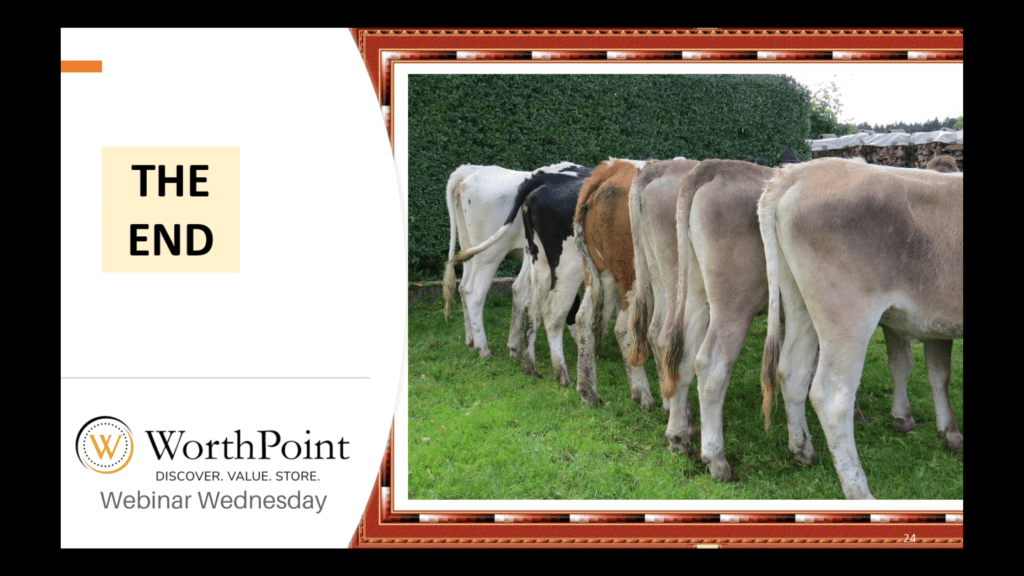
Danna: That’s a wrap. Thanks, everybody. Happy leather cleaning. Bye.

Leather Webinar Replay
Want to keep learning? Join the webinar list and receive invites to all future online webinars:
https://mailchi.mp/worthpoint/webinarlist
